When a schoolchild is faced with the task of learning the multiplication table, then, of course, parents want to help him and are looking for which one is the best. There are a great many methods, but everything requires an individual approach to your little one. We will tell you how you can easily explain to your child the principles of multiplying numbers and help him remember it in the shortest possible time.
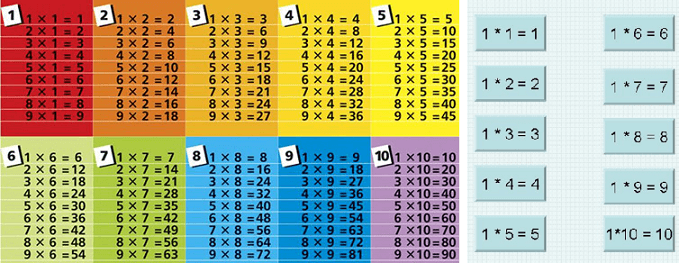
Most likely, multiplying by 1 and 10 will be easiest for a student. This counting is very easy for kids, since there is nothing scary or difficult here. Try to draw a few examples in front of your baby, such as 1*2=2, 1*5=5, 8*1=8. In any case, the number will remain unchanged.
With the 10th it will be a little more difficult, but if you explain everything normally to an 8-9 year old child that multiplying by 10 is similar to the principle by 1, but you need to add 0 to the result, then the child will remember this very easily. Be sure to tell your student that having learned multiplication by 1 and 10, he will already know the first and last line in all other columns.
Multiply by 2
With two it will also be easy, since you tell your child that the correct result can be obtained by adding the two numbers proposed. For example, if a child has an example of 2 * 6, then he just needs to add 6 + 6 together and get 12. After each lesson, be sure to take a break for at least an hour, and it is best to continue classes every other day.
Multiply by 3
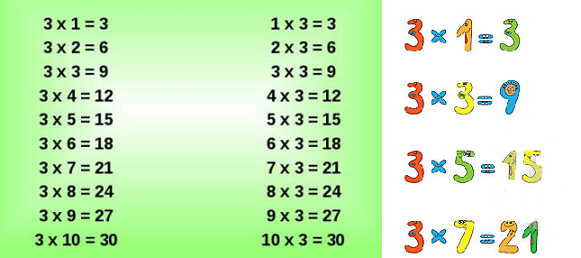
With multiplication by three, you can try the same method as with two. You just need to explain to your child that 3*4 and 4+4+4 will equally equal 12. If this method is absolutely not suitable for your child, then try playing with associations. First, ask your child to fantasize and sketch his associations with the numbers 1 to 9.
After this, start coming up with a story for each example, and this way the student will remember the 3-tablet much faster. Allow your child to play with these drawings and come up with stories for them on their own. You can draw your own story for each example, it will be remembered much easier.
Multiply by 4
To help your child easily remember multiplication by 4, remind him of the principle that you used when learning columns with twos. But only now we will need to double the required number and double the result. For example, 4*4= 4*2=8*2=16.
Multiplication table 4
Multiply by 5

When studying the operation by 5, you should immediately draw the attention of your 8-9 year old child to the fact that with the result of multiplication in this column, all results will end with either 5 or zero. Also note that 5 is half a ten. Therefore, the answers will be easier to multiply the number not by 5, but by 10 and then divide the result in half. For example, we need to find the answer to the example 7*5. Try 7*10, it will be 70. Now divide 70 by 2 - it will be 35.
Multiply by 6
For six, there is also a way to make memorization easy for children 8 years old, and this column of the tablet was learned in an hour. Try to remind your child how he learned the table for 3 and invite him to add the same number to the result. For example, 3*5=15, which means 6*5=3*5+15=30.
Multiplication table 6
Multiply by 7

If multiplying by 6 is no longer difficult for an 8-year-old child, then understanding how to multiply by 7 will be as easy as shelling pears for him. If you need 7*2, then you just need to add 7 and 7, you get 14. Example 7*4 would mean that the number needs to be doubled twice, and so on. You will only need to write down and learn separately multiplication by 7, 8 and 9.
Multiply by 8
By analogy with previous methods, multiplying by 8 can be compared to four, only the result will need to be doubled three times. If in our example it is written that 4 * 8, then we multiply 2 by 4, the resulting eight by two more, we get 16 and then we multiply this result by 2 more and we get 32.
Multiplication table 8
Multiply by 9
There is a simple and very easy method for multiplying by 9 on your fingers. Children 8-9 years old will definitely like it, since it can be learned in just a few minutes, and not in an hour or two.
Ask the student to place their pens on the table, palms down. Count your fingers from left to right. So, for example, we have the example 7*9. We count 7 fingers from the right. Bend the finger where you stopped counting. How many fingers are not bent to the left of the seventh - six.
This means our answer will be six tens. How many fingers to the right of the bent one - three. This will be the number of ones in the answer. So we realized that the answer is 63. This study of the multiplication table on the fingers will be useful. You shouldn’t scold your baby for using this method for too long. It is this method that will allow the child to firmly remember multiplication by 9.
Multiplication table 9
How to multiply numbers in a column
Of course, after a 9-year-old child has learned the multiplication table well, he will need to be taught to multiply two-digit columns, and then three digit numbers. Numbers that are multiplied by each other are called factors. They are called the first multiplier, the second multiplier, and so on. The result of multiplication will be called “product”.

To multiply two numbers, you will need to arrange them in a column on top of each other so that the ones are on top of the ones, the tens are on top of the tens, and so on. The next step is to multiply the top number by the digit of the bottom number. First, one is multiplied, then tens, hundreds, and so on. The result must be written below the line.
If, as a result of multiplication, you get a number that is greater than ten, only the last digit of the result goes under the line, and the ten, if there is one, is written on top. Then this ten must be added to the result of multiplying ten by one. Multiplying the top number by the tens and hundreds of the bottom number follows the same rules.
If you give your child the opportunity to calmly learn one or another method of memorizing the multiplication table, then he will quickly begin to count. Do not insist if the baby has no desire to study. You may well follow your child’s lead, allowing him not to repeat the table.
Show him specific examples in life, where the table may be useful to him. For example, ask your daughter to count how many candies you need to buy so that her friends all get three. It will be easy and interesting for the girl to find the answer, since it directly relates to practice and life.
Nowadays, many parents believe that a child, even before entering first grade, should learn not only to write and count, but also to know the basic techniques of algebra: addition, subtraction, multiplication and division. That is why mothers and fathers are faced with a serious question: “how to teach a child to learn the multiplication tables”?
Basic rules for obtaining optimal results
Of course, you can teach your child using basic methods (they are described below). However, parents who are determined to make it easy for their child to learn the multiplication tables must not only learn special techniques (with which they can teach their child the multiplication tables much easier and faster), but also choose the most optimal method for their child.
Regardless of which method you choose, the following rules must be carefully observed:
- To make learning easy for a child, frequent breaks are necessary;
- An objective assessment of the child’s abilities is necessary: a preschooler simply cannot physically learn the entire multiplication table in three hours;
- Be sure to praise your child for every success, no matter how small;
- It is strictly forbidden to scold a child if he cannot learn something. It is best in this case to take a short break and then return to the stumbling block again;
- Try to turn learning the multiplication table into a game: if the child finds it interesting and fun, then all the knowledge will be absorbed much faster than if parents force the fidget to sit with boring books.
Basic way to learn multiplication tables
A parent who is seriously thinking about how to learn the multiplication tables with a child can, in a burst of inspiration, remember his own childhood: counting sticks, a school board, a strict teacher and a huge table completely filled with numbers. This is the table that is most often used in schools, so it is recommended to spend at least the first lesson with it.
First, you should print (or draw) two versions of the tables: the first is completely filled out, and the second is only with numbers around the edges. It is advisable that the second table be large, since the child will enter the numbers independently.
During the first lesson, try to explain to your child the basic meaning of multiplication: it is the same as addition, only multiple times. Use small numbers as an example to show how multiplication works. An example option might look like this:
“Here are numbers two and three. In order to multiply three by two, we need to add three and three. How much will it be? That's right, six!”
What should you do after the first “trial” lesson with the table?If everything went well, try working with the table again: explain to your child the peculiar “mirroring” of multiplication:
“Now let’s see what two times three is. In order to calculate this, we need to add two to two, and then add two again. Let's write them down in a column. How much will it be? Good girl, six! You see, three times two is six, and two times three is six. Now you’ve learned the first rule of multiplication: changing the factors (these are the numbers you multiplied) will not change the product (the number you got in the answer)!”
Be sure to praise your child.
“See how quickly you counted! Learning the multiplication table is easier than it seems at first glance!”
Be patient.
If a child cannot quickly perform the addition operation, there is no need to prompt him: he will definitely count on his own, he just needs more time than an adult.
If it took a little time to explain this rule, then you can start filling out the part of the multiplication table with the number 1 (usually children quickly understand the meaning of multiplication by 1). As soon as the child’s attention begins to wander, you should stop the lesson - the preschooler will not learn more material.
When you click you will have a large printable table
Subsequent classes
Make a large number of multiplication table example cards. Before each lesson, be sure to let your child solve familiar examples, otherwise the knowledge will simply be forgotten.
Small tricks will help you remember results easier
After your child learns multiplication involving one, you can try multiplying a number by a ten, or tens by a number. Teaching a child to add an extra zero to each number will be much easier than, say, teaching him to multiply numbers by six.
Multiplying by two, three and four. Typically these actions do not amount to special labor, since they can be easily counted on your fingers.
How to teach a child to multiply by five? It’s very simple: any even number will end in 0, and any odd number will end in 5. Counting them is a matter of technique.
I've practically learned the entire multiplication table. But how can you easily and quickly learn multiplication by the most difficult numbers: six, seven and eight?
Most likely, you will simply have to memorize them: even adults often get confused when multiplying these numbers.
Is there an alternative to the table?
If during the first lessons you see that it is clearly difficult for your child to remember even the simplest examples, do not swear at him under any circumstances, but start trying alternative methods.
 The method of studying the multiplication table with the help of poetry seems interesting: now there are entire books that make it possible not only to easily improve “sagging” numbers, but also to learn the multiplication table from scratch. Fairy tales about numbers are also interesting: in a humorous form they can tell about one of the most difficult operations of mathematics to understand: multiplication.
The method of studying the multiplication table with the help of poetry seems interesting: now there are entire books that make it possible not only to easily improve “sagging” numbers, but also to learn the multiplication table from scratch. Fairy tales about numbers are also interesting: in a humorous form they can tell about one of the most difficult operations of mathematics to understand: multiplication.
However, studying with the help of poems or fairy tales alone can be infinitely long without the use of such additional techniques as flashcards. Remember that the child’s brain needs tireless repetition - only then will the information be not only mechanically learned, but also understood. And this is a guarantee that the baby will not forget the multiplication table until old age.
How can you understand in advance whether it is easier to learn the multiplication table through a simple table or by adding poetry games with your child? Remember the child’s character: if he is a strong humanist, then games will definitely appeal to him, thereby making the learning process more fun.
Toys always help
If you have absolutely no ideas on how to quickly help your child learn this complex multiplication table, then use a win-win option: baby's favorite toys.
 The only criterion for toys is that any outsider should easily understand that they illustrate multiplication. For example, when multiplying two dolls by three, you should get exactly six dolls, and not four dolls, a puppy and a crocodile (in this case it will be extremely difficult to teach a child!). Also, if you choose to learn with toys, then don’t try to teach your child to count on their fingers instead – these are two completely different methods!
The only criterion for toys is that any outsider should easily understand that they illustrate multiplication. For example, when multiplying two dolls by three, you should get exactly six dolls, and not four dolls, a puppy and a crocodile (in this case it will be extremely difficult to teach a child!). Also, if you choose to learn with toys, then don’t try to teach your child to count on their fingers instead – these are two completely different methods!
One of the most interesting ideas was the idea of one father to use a huge number of LEGO parts, which were scattered in huge quantities throughout the apartment. Taking the smallest piece as one, the father began to show his son the basics of multiplying by two, three and four (after all, there was a lot of LEGO, so they did not experience a shortage of pieces). As a result, all the lessons were held in the form of a game, and the father could not even imagine that teaching his son multiplication would be so easy and quick!
Fingers and multiplication
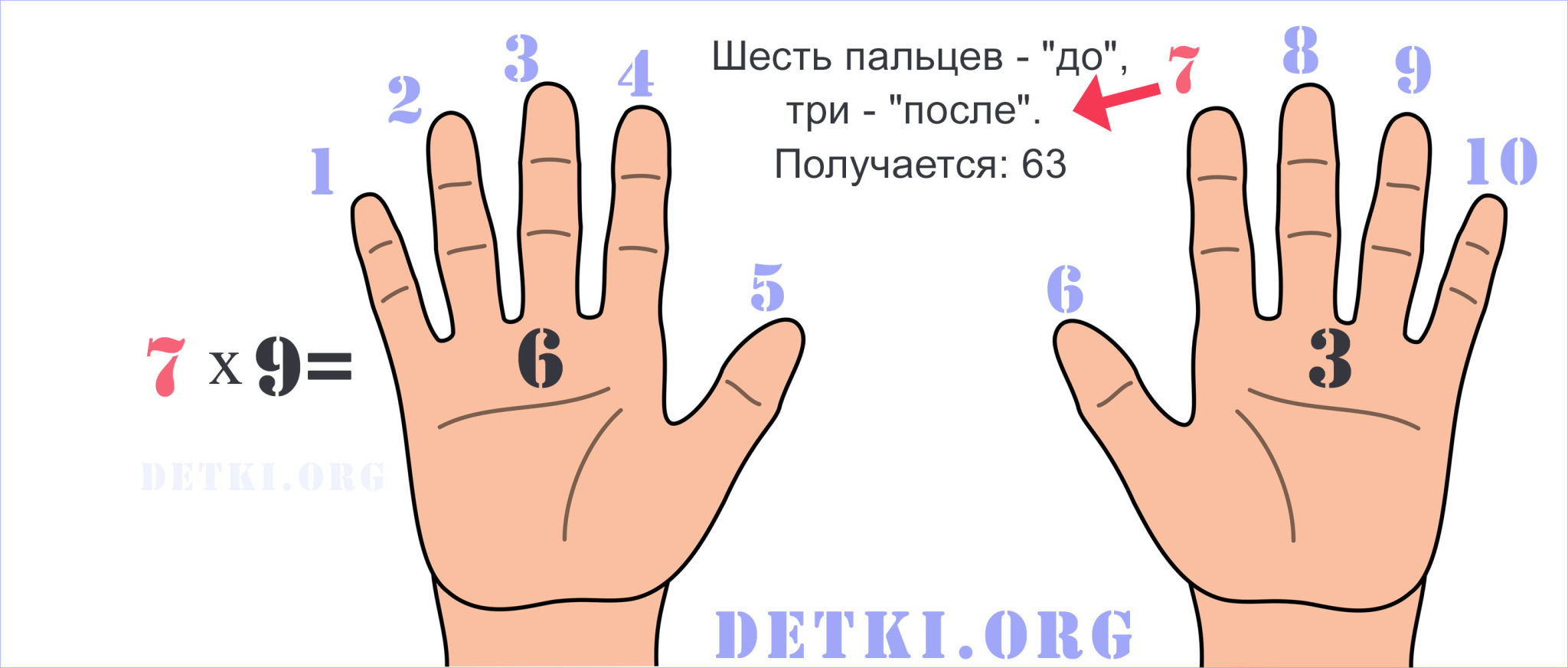
Multiplying by NINE using your fingers - instant results
Oddly enough, you can quickly learn the multiplication table even on your own fingers!
Many parents do not approve of children's habit of checking all calculation results on their fingers, arguing that it is easy to count only small numbers on their fingers.
In fact, this is not entirely true: you can easily learn the multiplication table (and quite quickly!), using only your own fingers and knowledge of interesting mathematical patterns (however, this will not save your child from solving examples to repeat the material).
Of course, with the simplest examples everything is clear: ten fingers are enough for calculation. But what about multiplying by nine?
In fact, you can: for example, multiplying by nine is done incredibly quickly: in just one step. We need to count (starting with the left thumb) to the number that we multiply by nine (or by which we multiply nine). Numbers to the left of it will give tens, and numbers to the right will give units. This is truly a fantastic method. Makes multiplying by nine much easier.
Of course, it is extremely difficult to learn a table in this way without repetition, so choosing this approach requires a large number of practical tasks.
Change is necessary
Regardless of the child’s age, he needs a large number of breaks (preferably every 10-15 minutes), otherwise it will not be possible to easily learn the basic laws of multiplication: after 10 minutes of continuous classes, the child will be distracted every now and then by a cat, a ray of sun peeking through the window, a ringing sound heard on the street and so on.
How to maximize the level of effectiveness of classes? Firstly, you should draw a table with a clear lesson plan (there should be short breaks in it) and follow it all the time.
Secondly, you need to show imagination: you can learn the material in game form. For example, you can create your own card game.
Game example: cards are created (their number may vary, repetitions and bonus cards are possible). The main thing is that the child knows all the examples on the cards participating in the game. The basic rule of the game is that the player, without looking, draws a card and solves the problem within a certain time. The one who scores the most points will win. Bonus cards can add an amount of time, give you the opportunity to choose an example, and so on.
Thirdly, do not hesitate to divide into parts: learning one large table is more difficult than many small tablets.
In addition
- It would be a good idea to hang a table above your baby’s bed, as well as in his playroom: even without studying, he will automatically glance at it, thereby gradually memorizing the numbers;
- Train all your child’s skills more often: instead of multiplying seven by eight, ask your child to name numbers that, when multiplied by each other, will give 56;
- If your child is already going to school, ask the teacher about her teaching methods. It might be worth using a similar method to learn the material faster;
- Be patient: it is easier for your child to learn the material when he is not limited in time, at least at first.
Maria Soboleva
Teaching the multiplication table with your child: the most effective ways
At some point, parents will definitely be faced with the question: how to quickly learn the multiplication table for a child? He cannot cope with this task on his own; he needs help from adults. And also - correctly chosen memorization methods.
Basics of training
To help your child quickly learn the multiplication table, it is best to first explain to him the essence of this action. He already has the concept of addition and subtraction. Let us explain that 2 multiplied by 2 means adding two twos, that is, 2+2.
More is possible complex examples result: 3 multiplied by 4 means adding three 4 times - 3+3+3+3.
It’s good to back up your explanations with real examples that a child can understand: “Grandfather brought 2 sets of markers for you and Ksyusha. Each contains 5 pieces. How many markers in total will you get? How will we calculate: 5 plus 5 or 2 multiplied by 5? And so, and so we get 10.”
Gaming techniques
How to quickly learn the multiplication table for a child? Of course, use gaming visual techniques. Take a box and balls. We put them in a box in pairs. Then the next two balls, then another and another. It turned out like this:
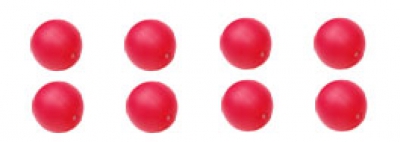
Methods for learning multiplication tables
Help your child learn the multiplication tables quickly different methods. The fact is that some children are good at memorizing numbers simply mechanically (at this age, this type of memory is quite well developed in them).
Some will need visual reinforcement: videos, drawings, emotional support, gaming techniques and tools such as online games and poetry work well.
Multiplication tables - where to start?
The child needs to be explained how the Pythagorean table works: there are numbers in columns and rows, and where they intersect, we look for the answer - the product of numbers, for example, six by eight is forty-eight (6x8 = 48).
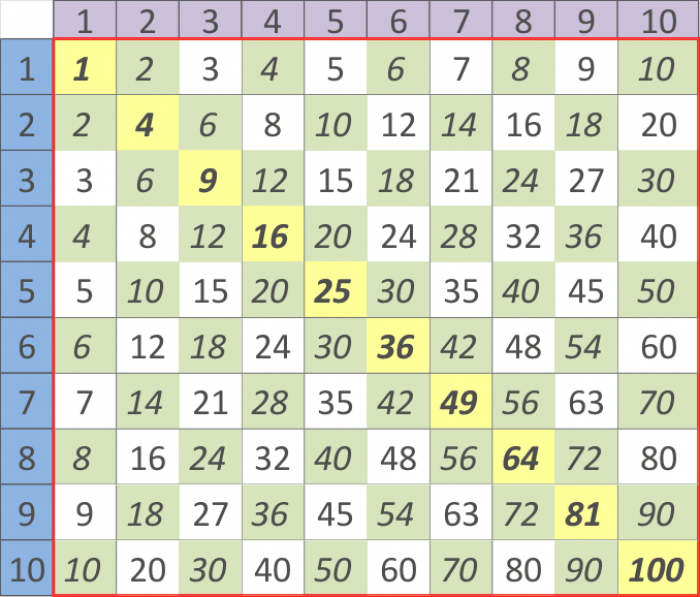
You can start studying the table with its usual version. Explain to your child right away that you shouldn’t be afraid that it’s so big at first glance. Many examples there are already known and do not require memorization.
For example, multiplying by 1 and 10. What does it mean to multiply a number by 1 - take it 1 time. Two will remain a two, four will remain a four, and so on. That is, the number will not change. And multiplying by 10 is also easy - just add a zero to the number: 5x10=50.
Multiply by 2, by 5 and learn squares of numbers
How to quickly learn the multiplication table for a child - memorize more at first simple options. Multiplying by 2 is usually not difficult for children. It's like adding another one to a number.
You can then learn how to multiply by 5. The answers will end in either 0 (even numbers) or 5 (odd numbers).
The next stage is memorizing the squares of numbers. You can’t do this without repetition and reinforcement. The child just has to remember that 8 by 8 is 64, and 9 by 9 is 81.
Usually the first difficulties begin with multiplication by 3. Here it’s time to introduce additional memorization methods - visual techniques, for example, playing cards or associations using poetry. About them - a little lower.
How to multiply by 6, 7, 8 and 9
This stage is the most difficult, and some examples you just need to remember. You will have to constantly repeat these few of the most difficult pieces with your child until the numbers become automatic.
The main thing is to show the child that he already knows almost the entire table, but there are mere trifles left. These are the insidious meanings that are so difficult to remember:
6x7=42
6x8=48
6x9=54
7x8=56
7x9=63
8x9=72
About changing factors
Adults understand that 4x3 = 3x4. But the child needs to be explained that if the factors are swapped, the result will not change.
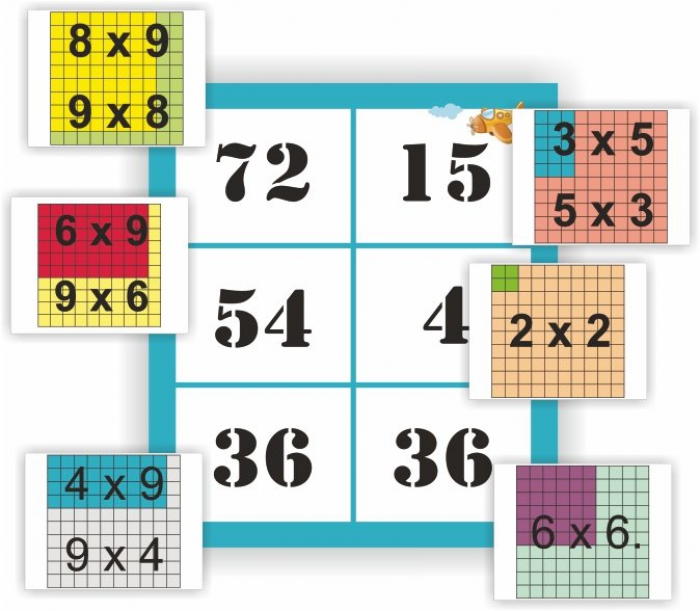
Then it will be much easier for your student to remember how much, for example, 7 times 4 is. If he forgot, let him remember multiplying 4 by 7. This important point in learning the multiplication table.
Different methods for learning the multiplication tables
A variety of ways to study the multiplication table helps you find the one that's right for your child.
Flashcards
All sorts of online games on the Internet also promote memorization, but the most reliable and proven method remains the visual method using memory cards.
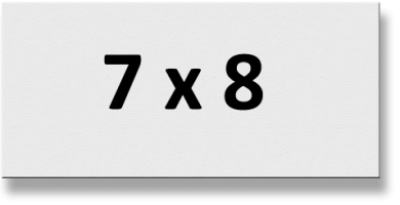
Make cards with examples: for example, write 7x8 on one side and the answer on the other. How we play - the child takes a card, answers the question and turns it over to see the answer. If he answered correctly, he keeps the card for himself; if not, he takes another card. The one with the most cards wins. The game involves repetition and memorization, but in a fun way.
One such option is digital lotto. Enter the answers from the table into the cards and make cards with example tasks. Gameplay stimulates memorization.
Multiply on your fingers
There is a way to count - on your fingers. Suitable for multiplying by 9. You need to place your hands palms down and straighten your fingers. We need to multiply 7 by 9. Bend the 7th finger and look - the number of fingers before it will be equal to tens in the answer - 6, and after the 7th finger - to ones, that is, three. We get 63.

There is another interesting method for multiplying by 9. You need to multiply a given number, for example 6, by 10 (6 by 10 = 60). Now subtract 6, you get 54.
Repetition is the key to memorization
To make it easier for your child to remember, give him visual aids. He must constantly see examples before his eyes and repeat them. You can decorate the table brightly and colorfully and hang it in the children's room and kitchen. This way the information will be remembered easier.
Educational poems
For many children, especially those in the humanities, it is much easier to memorize the table using a poetic form. The most famous similar poems were written by Marina Kazarina and Alexander Usachev:
Multiply five by six
As a result, we get THIRTY.
And five is seven - easy to count -
The short answer: THIRTY-FIVE!
Once a deer asked an elk:
- What is seven eight? —
Elk did not bother to look into the textbook:
- Fifty, of course, six!
Cartoons for memorization
If you set yourself a goal, you can find a lot of interesting cartoons to help those learning the basics of multiplication. Children always respond well to this form of presenting material, so we recommend actively using it. An example is in this video:
Take it for yourself and tell your friends!
Read also on our website:
Do you want to know how you can captivate children with something educational and interesting, and at the same time earn authority in their eyes? Then we suggest you organize these experiments for children that will make you a real magician - although in fact, each of them has a simple scientific explanation!
Time flies by, and now your baby is already... Not only his performance at school, but also his future life depends on how diligent he is in his studies.
To make it easier for a child, psychologists and teachers recommend that parents not only monitor the completion of homework, but also help them learn. This does not mean that you need to solve problems instead of your student.
Help lies in training attention, logic and thinking. After all, a child has so much to learn. The multiplication table is the largest amount of information that needs to be learned in elementary school and remembered for life. Naturally, a child of 8-9 years old cannot do without the help of his parents.
Where to start learning
First you need to find out whether the child accurately understands what he needs to learn. Children at this age are very familiar with the concepts of addition and subtraction of two-digit numbers. This knowledge will become a support. If the student understands that 5x8 is the same as 5 times 8, then that’s already half the success.
Very convenient to use special table, in which the numbers from 1 to 10 are written horizontally and vertically. Where they intersect, the number that is obtained as a result of their multiplication is written. You can draw such visual material yourself or download it from the Internet.
For greater clarity, you can draw in an art editor and print cards that illustrate the principle of multiplication using simple, understandable things, for example, 6 bunches of carrots. Each contains 4 carrots (6x4=24). Come up with your own image options.
In order not to scare the young schoolchild and instill in him confidence in himself, start working on the table better with multiplication by 1 and 10. The child will see that not everything is so scary and difficult and will begin to show interest in learning. Multiplying by 2 shouldn't be a problem either.
Starting with the triple, you can explain to your child the law of commutativity - the sum does not change when the factors are changed. If the child learns this, then he will need to memorize less. It is necessary to show the student that in rows and columns with the same numbers, numbers are repeated.
The best form of learning is play
It is important not to forget that junior schoolchildren They are still just children and their main activity is play. There are so many fun ways to learn your times tables. You can find games on the Internet or even come up with something of your own using your imagination.
It is advisable to observe the child and find out which type of memory predominates in him: visual, auditory, verbal-logical or motor. This will help you decide what to focus on in your studies.
Game "Multiplying Circles"
We take many small sheets of paper and a single hole punch. We put two sheets of paper together and make one hole. We see that we got one circle on two pieces of paper (2x1=2).
Accordingly, you can take any number of sheets (up to 10) and make as many holes as you like within 10. We calculate the answer, it corresponds to the number of circles. Let your child use the hole punch independently. The game involves both motor and visual memory.

Imagination games
For a visual child select a thick album of paints, markers, pencils. Let him draw his own multiplication table. Write down on one side mathematical example 6+6+6+6+6+6+6=6x7=42, and on the other let the child give free rein to his imagination. For example, he will draw a castle with 7 large windows. The windows are separated by a decorative lattice of 6 squares. This is a great activity for when you have plenty of time for creativity and you don’t have to rush anywhere. Verbal-logical memory is also involved here.
To the baby who has auditory memory predominates It is best to memorize rhymed quatrains about the multiplication table. You can also connect motor memory here if you show with movements everything that is discussed in the verse.
If possible, involve the whole family in the study. There is a video on the Internet where a grandfather raps about the multiplication tables to his grandchildren. It is unlikely that they will ever forget her.
Game "Crocodile"
You can play the game “Crocodile” with your household. You just need to show the answer to an example from the multiplication table. Emotional memory will be involved in such a pastime. What brings strong emotions is remembered very firmly and for a long time.
Other games for learning
The fingers of both hands will help you remember the table of multiplications by 9. Place your hands in front of you.
9x1=9 Bend the first finger on the left side. Nine fingers left.
9x2=18 Return to the starting position. There are ten fingers in front of you. Since you need to double, bend the second finger to the left. On one side, the only finger left from the bent one (tens), and on the opposite side - eight ones.
By analogy, we do this with other fingers. Do this unusual exercise with your child several times every day, and he will quickly remember the complex column from the multiplication table with nine.
Targeted Memorization
Many teachers believe that it is better to cram the multiplication table from complex to simpler, that is, from the end. This technique is quite difficult for children to understand. If you learn the table from the beginning, then the little student, even if he has forgotten the answer, can quickly count on his fingers. This will not work with the “9” table. 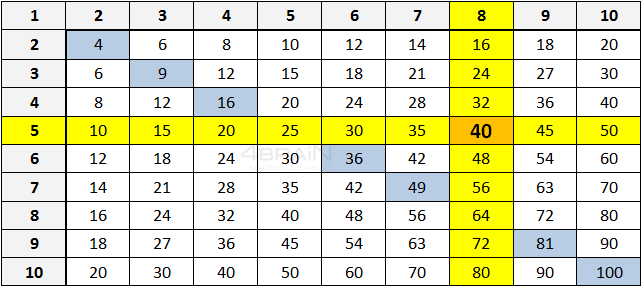
Squares of numbers. The square of a number is the result of multiplying it by itself. There are only 10 squares in the table. They need to be learned by heart. The most difficult to understand are the multiplication tables for 6, 7, 8,9. If a child has memorized the table up to 5 and the squares of these numbers, then for cramming he only has to remember the answers to multiplying the remaining four digits (6, 7, 8, 9).
If you paint over everything you have learned in the previously proposed tablet with a colored marker, then there will only be 6 pieces left that you just need to memorize.
6×7=42
6×8=48
6×9=54
7×8=56
7×9=63
8×9=72
To help your child master and memorize not only the multiplication tables, but also other material, it is recommended to use simple rules.
- Memory productivity depends on the time of day and night. Productivity is greatest between 8 and 12 noon. Afterwards, it decreases significantly, and in the evening, if the body is not tired, it increases again.
- Unfinished actions are remembered better.
- Law of the region. What is learned at the end and at the beginning is remembered best. In the middle of lessons with your child, you should insert simple fragments, and begin and end with more complex new material.
- For older children, we can recommend repeating the table yourself. To do this, they can make themselves cards with examples and answers and hang them around the apartment.
Advice: It’s better to make them on multi-colored paper and change them periodically, as the eye gets used to the prompts and perceives them as a piece of furniture.
Instead of a conclusion
If you use the above techniques, you can quickly learn the multiplication table with your child. In addition, you can use other methods to develop children’s memory and logic, which will help them successfully master the sciences.
Parents of schoolchildren often face a rather difficult problem: how to help their child learn the multiplication tables? Children study the Pythagorean table in the second grade primary school. At this age, mechanical memory works perfectly, so many people simply “memorize” the material. But not all children manage to learn the multiplication tables in this way. Today, the Internet provides an exhaustive list of various techniques that allow comfort for the child and with special attention to his individual characteristics learn the multiplication table.
There are various ways to memorize the Pythagorean table: proverbs, poems, songs, fairy tales, games, as well as various visual materials. However, no matter which learning path you choose, it is worth remembering one thing: the child must understand the very principle of the multiplication table!
This is important! By the time your child starts learning the multiplication table, he will already know the logic of such an arithmetic operation as addition. First of all, it is worth explaining to the child the process of multiplication itself. For example, 3 times 4 means adding the number 3 four times or 3+3+3+3. Use associations, let it not just be the number 3, but three cars or three dolls. The child must have a good understanding of the arithmetic operation itself - multiplication. If you explain to your child that, in essence, multiplication is a short form of adding a specified number of identical terms.
Only after the child understands the essence of the arithmetic operation, begin to study the table itself.
| 1 | 2 | 3 | 4 | 5 | 6 | 7 | 8 | 9 | 10 |
| 2 | 4 | 6 | 8 | 10 | 12 | 14 | 16 | 18 | 20 |
| 3 | 6 | 9 | 12 | 15 | 18 | 21 | 24 | 27 | 30 |
| 4 | 8 | 12 | 16 | 20 | 24 | 28 | 32 | 36 | 40 |
| 5 | 10 | 15 | 20 | 25 | 30 | 35 | 40 | 45 | 50 |
| 6 | 12 | 18 | 24 | 30 | 36 | 42 | 48 | 54 | 60 |
| 7 | 14 | 21 | 28 | 35 | 42 | 49 | 56 | 63 | 70 |
| 8 | 16 | 24 | 32 | 40 | 48 | 56 | 64 | 72 | 80 |
| 9 | 18 | 27 | 36 | 45 | 54 | 63 | 72 | 81 | 90 |
| 10 | 20 | 30 | 40 | 50 | 60 | 70 | 80 | 90 | 100 |
Studying the multiplication table with your child
Teach your child to understand the Pythagorean table. Explain that when you multiply a number from the leftmost column by any of the numbers, you get their product, which is located at the intersection of the desired row and column. When the child learns to easily navigate the table itself, it is necessary to begin the most important thing - memorizing the table itself.
Playfully memorize the multiplication table!
Unfortunately, for many children it is quite difficult to approach the issue of memorizing the table responsibly. It is much easier to teach using a game element. It will be much easier for children to remember information that they find truly interesting.
A fairly simple and effective game is playing with cards. Draw or print with your child various options examples from the multiplication table:
- 3x7=?
- 2x4=?
- 5x8=?
You can come up with a great many variations of such a game. For example, your child has learned all the examples of multiplication by 2 and 3. Make only these cards with your child, and then add new ones to them. Another option better memorization tables can be composed of cards like:
- 3x?=15
- ?x2=6
- 10x?=10
This is interesting! Use your imagination! It will be much easier, and most importantly, more interesting for the child to remember the material if the cards with examples are bright and colorful. Instead of boring questions, funny animals or loved ones will appear fairy-tale heroes baby. Use your imagination, and then your child will be happy to guess what number is hidden behind the back of the noble Puss in Boots or the funny Carlson.
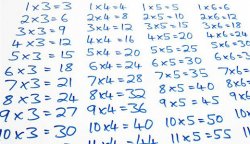
Learning the multiplication table with your child - basic rules!
So that it is not difficult for a child to memorize the Pythagorean table, and the information received does not turn into mush, it is necessary to follow several simple rules:
- Seeing the Pythagorean table, even the smartest kid can get scared. Explain to your child that there is nothing difficult in understanding this information, and at one time, both mom and dad, and grandparents, taught this table.
- First learn simple multiplication, for example, by one. Explain to your child that when multiplied by 1, the result is always the same number that we multiplied by one. For example, 1x1=1, 5x1=5, 10x1=10, etc. Multiplying by ten is also not difficult to convey to a child: it is the same as adding zero to a number every time. For example, 2x10=20, 3x10=30. The main thing is that the association with the appearance of a zero in a number is imprinted in the child’s head, and he can solve examples not only on paper, but also in his mind.
- When you have learned and repeated the simplest examples, begin to move further along the table with your child.
- After each memorization of an arithmetic operation - multiplication by 2,3,4,5,6, etc. do not forget to repeat the material covered with your child (you can do it in the form of a game, which was described above).
- Very often, a child, having learned multiplication by 2, begins to get lost if an adult asks him: “how much is 2x5?” In such a situation, you need to be careful when explaining to the student the communicative rule of multiplication: when the places of the factors are changed, the product does not change.
Finger games – learning the multiplication tables is fun!
If your child has a hard time learning the multiplication tables. You can use the fingers of a young accountant. A great example would be learning to multiply by 9. Have your child place both hands on the table, palms down. Each finger will represent a number from one to ten. For example, we want to multiply 9 by 4. We count from left to right to 4 - we get the index finger of the left hand. We bend it and count the number of fingers on the left. There are only 3 of them - that's dozens. Pure fingers on the right - 6 - units. Answer 36. This memorization option will bring a bit of magic to the learning process, and your young accountant will definitely be carried away by such an interesting learning process.
Association game
Many children have well-developed motor and figurative memory, so it will be easier for them to remember tabular examples using various associations. For example, number 2 looks like a swan, and number 1 looks like a gnome with a curious nose. For example, in the case of multiplication 2x1=2, you can come up with the following story: One beautiful swan was very lonely. He wanted to find a friend so much that he looked for him everywhere. And then one day he met a gnome with a funny hooked nose. However, the gnome was very cunning and insidious that the swan barely escaped from him. So the swan remained in splendid isolation...
A great many such stories can be invented. Let the child dream up his own imagination, the main thing is that the story unites two multiplier characters, and the work is the logical conclusion of this plot. The more emotional and exciting the stories, the easier it will be for the child to remember this or that example.
Once the cause-and-effect relationships have been worked out with the help of a fairy tale, you can isolate the most important thing: “The swan met a gnome, did he make friends with him or was he left alone?” If your child answered everything correctly, then you need to ask him to compose this example in numbers.
Poems, songs, stories
This method of memorizing multiplication tables is suitable for children who are excellent at memorizing poems and songs. Children can be encouraged to memorize examples from the multiplication tables using poetry. Great option are the works of A. Usachev “Multiplication” and M. Kazarina “About Multiplication”. Thus, when solving this or that example, the child will make an association with the rhyming line.
No matter how you explain the multiplication table to your child, the main thing is to never get angry with your baby if he doesn’t understand something! Show patience, as well as your imagination, and then your child will have fun learning the multiplication tables!



